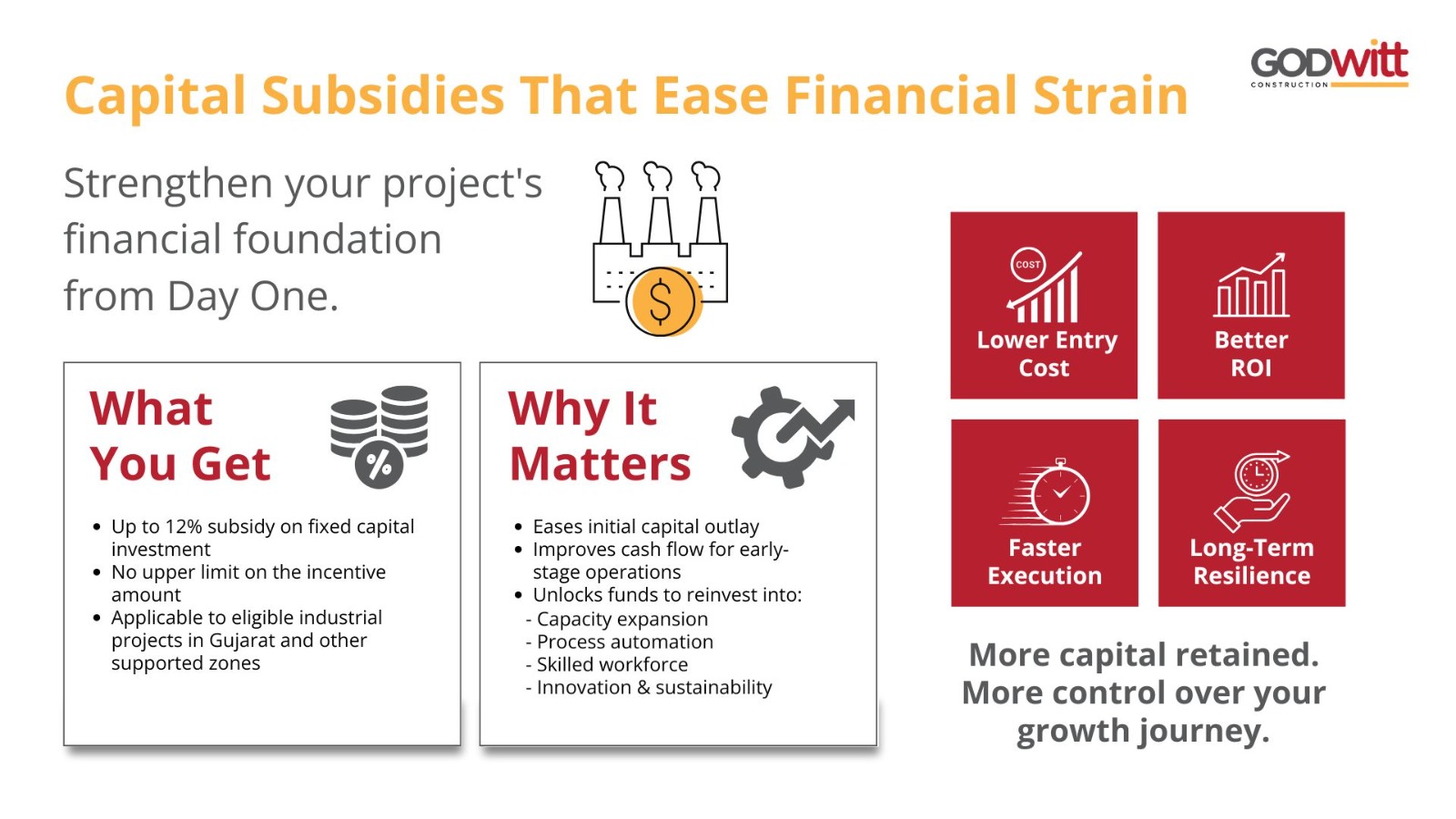Impact of Gujarat Government Policies on Companies' Decision-Making

Impact of Gujarat Government Policies on Companies' Decision-Making

Government policies have a direct impact on business choices about where to establish, grow, or move operations. It greatly influences the cost, schedules, and long-term viability. Factors like land access, infrastructure, regulatory ease, and financial incentives play vital roles. Through a combination of fiscal incentives, strategic infrastructure investments, and simplified regulatory frameworks, Gujarat is paving the way for businesses to grow faster, more efficiently, and sustainably.
Impact of Gujarat Government Policies on Business:
Gujarat Industrial Policy 2020
Gujarat has long been at the forefront of India’s industrial landscape. The Gujarat Industrial Policy 2020 aims to boost industrial growth by offering incentives and support for key sectors, large investments, start-ups, research, innovation, infrastructure, and businesses looking to relocate. With an annual outlay of Rs 8000 crores, it is designed to attract large-scale investment to Gujarat.
What Companies Need to Know
- Capital Subsidies that Ease Financial Strain
The policy offers capital subsidies of up to 12% on fixed capital investment, with no upper limit on incentives, helping businesses offset initial costs and reinvest savings into growth and innovation.

- Tailored Incentives for Key Sectors
Industries such as logistics, warehousing, and manufacturing receive additional support, ensuring they remain competitive in a rapidly evolving market.
- Incentivizes Private Investment in Industrial Infrastructure
With up to ₹30 crore in incentives for industrial parks and 80% funding for infrastructure projects, the policy ensures better facilities like roads, warehouses, and utilities. Thus attracting more occupiers and business expansion.
- Relocation Incentives for Global Players
It offers special incentives to industries relocating to the state, particularly those adjusting their supply chains post-COVID-19. These incentives are evaluated on a case-by-case basis, aiming to attract global businesses and support their smooth transition.
- Promotes Sustainability and Lowers Energy Costs
It helps industries reduce energy costs by promoting Zero Liquid Discharge practices certified by the Gujarat Pollution Control Board. It also supports cleaner production by covering up to 25% of project costs (up to ₹250 crore) for setting up, relocating, or upgrading polluting units.
The Gujarat Integrated Logistics and Logistics Park Policy, 2021
It directly improves cost efficiency, supply chain reliability, and ease of doing business. The policy recommendation boosts private investment in logistics infrastructure. By placing a focus on multimodal transportation, workforce upskilling, and sustainable practices like green energy adoption, it aligns with initiatives like Make in India and Atmanirbhar Bharat. For occupiers, this means lower costs, smoother supply chains, and access to world-class logistics infrastructure
What Companies Need to Know
- Lowers Financial Barriers to Entry
New projects can receive 25% of their Eligible Fixed Capital Investment (EFCI), with a maximum limit of ₹15 crore. Designed to encourage investment in logistics, it lowers financial barriers by making it easier for developers to establish and expand. In addition to capital subsidies, the policy offers various incentives, including interest subsidies, tax exemptions, skill development assistance, technology adoption support, and sustainability incentives.
- Cold Storage & Warehousing
Pushing the development of modern storage facilities such as cold/ambient storage, silos, and distribution centers at key locations, the policy improves cold storage and warehousing availability. It ensures better infrastructure, reduced wastage, and a more efficient supply chain for industries like pharmaceuticals, e-commerce, and agriculture.
- Logistics Expansion
It enhances logical efficiency by strengthening first and last-mile links to warehouses and ports. Facilitates technological adoption through digital tools like RFID, GPS, and real-time monitoring to improve cargo tracking and operational efficiency. The specialised skilling programs equip workers with industry-relevant expertise, offering a competitive workforce.
Gujarat Single Window Clearance System (SWCS)
The Gujarat single window clearance system is an investor-centric initiative by the government that helps streamline the business approval process. Unifying several key departments through digitisation plays a crucial role in reducing bureaucratic hurdles. If authorities fail to respond within the stipulated time, deemed approval is granted, ensuring smooth project progression.
How does it help the investors?
- One-stop portal: SWCS provides a single online interface for all required approvals. The time-bound clearance mechanism ensures that approvals are granted within a specified period. Furthermore, it integrates approvals from key departments such as industries, revenue, environment, labour, and power. This eliminates the need for businesses to approach multiple offices separately.
- Transparency and real-time tracking for investors: It provides an investor-friendly digital platform for real-time tracking of approval status. Automated alerts and updates help businesses stay informed about pending applications. This not only allows transparency in approvals but also ensures regulatory compliance.
Scheme for Financial Assistance to Integrated Logistics Facilities
This scheme was launched under the Gujarat Integrated Logistics and Logistics Park Policy in 2021. It has the provision to reimburse the stamp duty paid on land acquisitions for new logistics facilities and parks. Private developers who complete a minimum of 40% of the construction work between the period August 2021 to August 2026 will be eligible for this financial assistance.
What Occupiers Need to Know
- This benefit lowers entry barriers, encouraging more private logistics players to set up in Gujarat, directly benefiting occupiers with more competitive leases
- It incentivises rapid infrastructure development, and occupiers benefit from a growing inventory of ready-to-use spaces, accelerating their go-to-market timelines.
Gujarat Land Policy for Industrial Development
By guaranteeing the effective availability and use of land, the state has in place a strategic framework intended to promote and quicken industrial growth. It plays an important role in bringing investments, boosting manufacturing, and creating jobs while preserving social and ecological balance.
How does it help the investors?
- Streamlined Land Acquisition: It enables industries to secure government land on a long-term lease of up to 50 years, with the option for extension based on existing regulations. The lease is offered at 6% of the market value, making it more affordable for businesses to establish operations in Gujarat.
- Support for Industrial Clusters and SEZs: Benefits like expedited land permits, tax incentives, and streamlined compliance procedures promote sector-specific industrial clusters and Special Economic Zones (SEZs).
- E-auction: Gujarat actively uses an electronic auction mechanism to distribute commercial and industrial land transparently. Online auctions for different plots throughout the state are frequently held by the Gujarat Industrial Development Corporation (GIDC). It transforms the old-fashioned land distribution procedure into a quick, equitable, and effective technique. This ensures accountability, openness, and the best possible use of the land.
The National Logistics Policy (NLP)
The National Logistics Policy (NLP), launched on September 17, 2022, supports the PM GatiShakti plan to make India’s logistics network more efficient, integrated, and cost-effective. It aims to improve India's position in the Logistics Performance Index, with the aspiration of ranking among the top 25 countries by 2030. Furthermore, the policy also pushes a data-driven mechanism to facilitate efficient decision-making processes within the logistics ecosystem.
What Occupiers Need to Know
- Digital Integration: The unified logistics interface platform integrates 34 logistics-related systems, streamlining trade across multiple transport modes. It provides a single sign-on for users involved in trading goods across multiple modes of transport, allowing for digital integration in the logistics sector.
- PM Gati Shakti Plan Integration: It works alongside the PM Gati Shakti National Master Plan, focusing on strengthening the logistics sector through process reforms, service enhancements, digitisation, and workforce development. By improving soft infrastructure and streamlining logistics, this integration aims to boost economic growth and make businesses more competitive with a cost-efficient supply chain.
- Multi-Modal Transport Hubs: Initiatives like the Comprehensive Logistics Action Plan (CLAP) help strengthen logistics infrastructure and connectivity. Promoting digital integration and standardisation, it enhances multi-modal transport hubs, improving road, rail, and air networks for faster and more efficient logistics operations.
Delhi-Mumbai Industrial Corridor (DMIC)
Delhi-Mumbai Industrial Corridor (DMIC)is India's first industrial corridor built along the Western Dedicated Freight Corridor (DFC). Spanning a total length of 1,504 km, the corridor stretches from Dadri in the Delhi NCR to the Jawaharlal Nehru Port (JNPT) near Mumbai, traversing six states and 89 districts, including Gujarat.
Under this project, Gujarat will witness two developments: (i) Mandal-Becharaji Special Investment Region (2,849 acres) and (ii) Dholera Special Investment Region (5,560 acres)
What Occupiers Need to Know
- Industrial Nodes in Gujarat: Pre-developed industrial clusters with infrastructure are being established in Gujarat to lure businesses and foster economic expansion. With much of the groundwork already done, occupiers face fewer hurdles. Operational readiness of these zones accelerates product development and distribution cycles. Being part of a cluster creates synergies; companies benefit from proximity to a skilled workforce, ancillary industries, and logistics providers.
- Plug & Play Manufacturing Spaces: The plan has provisions for Plug & Play Manufacturing Spaces in Gujarat to promote industrial development in the area. Thus, by lowering setup time for businesses, occupiers stand to gain a competitive edge.
- Dedicated Freight Corridors (DFCs): They increase the efficiency of freight transportation by facilitating quicker and more dependable cargo transfer. By segregating freight from passenger trains, DFCs significantly improve scheduling and increase total transport capacity. They guarantee seamless multimodal connectivity and enhanced supply chain performance through their integration with logistical hubs such as warehouses and terminals.
Ease of Doing Business (EODB) in Gujarat Reforms
To facilitate investment, Gujarat has enacted many business-friendly policies. The state's digital governance, expedited approvals, and single-window system greatly cut down on bureaucratic red tape, which facilitates the establishment and growth of enterprises.
- Simplifying Labour Compliance: The state has used IFP (Gujarat’s single window clearance system) to digitise 14 important labour-related approvals, incorporating Digi-locker and a shared payment mechanism to facilitate compliance. This lowers staff onboarding delays, assures compliance efficiency, and lessens administrative load for businesses.
- Simplified Permits for Construction: The state has implemented a clear, online application process for getting construction permits and building plan approvals within predetermined timeframes. The National Monuments Authority (NMA) and the Airport Authority of India (AAI) are two important bodies whose approvals are integrated into a Common Application Form (CAF). Thus, it reduces time and expense overruns by speeding up project execution.
- Quicker Connections to Electricity: Through IFP, industrial units can submit online applications for new Low Tension (LT) and High Tension (HT) electrical connections. Businesses can expect approvals as fast as 15 days and final certification within 15 days of project completion. Such provisions prevent operational interruptions and project delays by guaranteeing a timely power supply.
Conclusion
Gujarat provides a comprehensive environment for industrial expansion, from capital incentives and expedited land acquisition to state-of-the-art logistics infrastructure and digitalised clearances. Gujarat's industrial environment provides a practical advantage for occupiers, not just a piece of paper policy. These regulations, whether they deal with quicker permits, less setup costs, smooth logistics, or ready-to-move infrastructure, are designed to lessen red tape and boost competition.
For More Godwitt's Insight: Drop us an Email !

Why to sign up for a newsletter
Open













